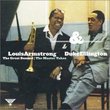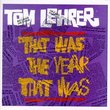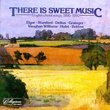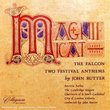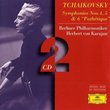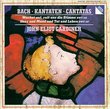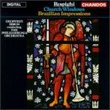| All Artists: Alban Berg, Wolfgang Rihm, James Levine, Anne-Sophie Mutter, Chicago Symphony Orchestra Title: Alban Berg: Violin Concerto "To the Memory of an Angel" (1935) / Wolfgang Rihm: "Time Chant" Music for Violin & Orchestra (1991-92) - Anne-Sophie Mutter Members Wishing: 3 Total Copies: 1 Label: Deutsche Grammophon Release Date: 3/16/1993 Genre: Classical Styles: Forms & Genres, Concertos, Instruments, Strings Number of Discs: 1 SwapaCD Credits: 1 UPC: 028943709323 |
Search - Alban Berg, Wolfgang Rihm, James Levine :: Alban Berg: Violin Concerto "To the Memory of an Angel" (1935) / Wolfgang Rihm: "Time Chant" Music for Violin & Orchestra (1991-92) - Anne-Sophie Mutter
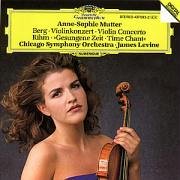 | Alban Berg, Wolfgang Rihm, James Levine Alban Berg: Violin Concerto "To the Memory of an Angel" (1935) / Wolfgang Rihm: "Time Chant" Music for Violin & Orchestra (1991-92) - Anne-Sophie Mutter Genre: Classical
Berg's Violin Concerto (1935) is considered by many the most accessible and emotionally engaging piece of music in the atonal idiom. His last completed work, the concerto was written as a memorial "to an angel" upon the pr... more » ![header=[] body=[This CD is available to be requested as disc only.]](/images/attributes/disc.png?v=15401716) ![header=[] body=[This CD is unavailable to be requested with the disc and back insert at this time.]](/images/attributes/greyed_disc_back.png?v=15401716) ![header=[] body=[This CD is available to be requested with the disc and front insert.]](/images/attributes/disc_front.png?v=15401716) ![header=[] body=[This CD is unavailable to be requested with the disc, front and back inserts at this time.]](/images/attributes/greyed_disc_front_back.png?v=15401716) |
Larger Image |
CD DetailsSynopsis
Amazon.com essential recording Berg's Violin Concerto (1935) is considered by many the most accessible and emotionally engaging piece of music in the atonal idiom. His last completed work, the concerto was written as a memorial "to an angel" upon the premature death of Alma Mahler's daughter Manon Gropius. But as with all of Berg's oeuvre, an autobiography of the composer's inner life is also thoroughly woven into the score. From the deeply reflective nuances of its quiet opening, Anne-Sophie Mutter takes the listener into the heart of Berg's ambiguous lyricism. There's a keen grasp, both by soloist and conductor James Levine, of the work's intricate structure and progression, but never at the price of a coldly disengaged intellectualism. Mutter summons a marvelous array of shadings and colors, effecting a truly haunting impression as tonality makes its ghostlike apparition, first in the guise of a folk song and, in the final part--following a violent cataclysm rendered with fiery power--in the variations on a quote from a chorale by Bach. Throughout, Mutter's intuitive realization of the psychic journey traced by Berg reveals the work's significance as closer in spirit to a requiem of farewell than a traditional concerto. Mutter's command of an animated tone that pulsates with expressive purpose inspired the contemporary German composer Wolfgang Rihm to write the other work on this disc, Gesungene Zeit ("Time Chant"). It's a mesmerizing neoexpressionist poem of shimmering, elongated string lines--later punctuated with dire eruptions from full orchestra--that seem to form an ether over which the soloist floats. Any sense of time measured in bars becomes negated as Mutter intones Siren-like threads of sound in the highest register. As with the Penderecki Violin Concerto No. 2 and other contemporary works she champions, Mutter plays with a gripping immediacy that indeed makes Rihm's imaginative novelty seem tailor-made for her. --Thomas May Similarly Requested CDs
|
CD ReviewsLyrical and Modern M. Friedman | New York Area | 03/01/2000 (5 out of 5 stars) "I admit to having been dubious about Anne-Sophie Mutter. There have been so many crossover fiddle-babes lately, that I had subconsciously filed her alongside Vanessa Mae and Linda Brava. That was unfair, probably sexist, and ill-considered, as this disc makes clear.Mutter is the real thing. She displays an extraordinary command of her instrument in what is really an very difficult and technically demanding piece.The Berg Violin Concerto is magical. At times jagged and strident and at times soaring and lyrical, it demands exceptional range from the soloist. Although it is [mainly] atonal, the concerto is capable of expressing great warmth and melodic invention in the right hands. Mutter's hands are the right hands.I hesitate to use another sexist term like "a woman's touch," but the truth is that there is something ineffably feminine in Mutter's performance here. Perhaps it's a lyricism that I don't here in Stern's performance of the same piece. Perhaps it's a lightness of touch. In any event, Mutter proves herself by seeming to start from the position that she has nothing to prove.I had never listened to Wolfgang Rihm's music before, and Gesungene Zeit remains the only composition of his that I have ever heard. I was quite dubious at first, having been disappointed in the past by neo-conservative "modern" composers like Gorecki and Part. However, I was pleasantly surprised by Rihm's composition on this disc.It may be just that Mutter plays the solo part so well, of course. But Gesungene Zeit has sort of griwn on me. It is minimal [rather than minimalist] in the same way as Ives' Unanswered Question, with some srong tutti chords in the second half. I'm not sure I would class it as one of the GREAT concetante violin pieces, but it does have a charm -- certainly as performed by Mutter -- that seems to improve with each listen." Absolutely, completely sublime! John Grabowski | USA | 02/16/2004 (5 out of 5 stars) "I have long put off writing this review because I was afraid my puny words could not match this recording, which is one of the very finest in my collection of 3,000+ classical CDs. I have about a dozen recordings of this work, as it's my favorite violin concerto (sorry, Beethoven), but this reading is in a league of its own: the only comparable recording is the famous Krasner/Webern, which was only the second performance of the work ever. (The work was written for Krasner...see post script.)Mutter and Levine are both on a very, very high level here, and the consistency is astonishing as well. Levine never holds back--the fortissimo climaxes in the second movement that represent the physical agony of 18-year-old Manon Gropius are truly hair-raising. (Some conductors perform this with more head than heart, but this is very emotional music and the emotional content should not be downplayed.) As someone else pointed out, Mutter give less vibrato than most in the Corinthian folksong, but the result is haunting, and here she was not abusing this technique, as I feel she now often does. Mutter was far more emotional and connected more with her audience, to my ears, in 1992 than she does today. I would not be interested in hearing what she does with this work now, sad to say, because I think she would turn it more into a vehicle for her technique than an exploration of the work.But in 1992 Mutter was not yet "Anne Sophie Mutter," and instead she uses her magnificent control over the colors of her violin to imply the evolution of Manon's life, consciousness and illness. Although the grief is already present when we begin, there are also many light and airy moments in the first movement that make the grief feel more like freshadowing. In the second movement the illness is already fully present, and we hear what can only be the wracking pain of the illness. Her violin thus sounds, if not weak, at least subdued and drained when the Bach Chorale enters. But the most astonishing effect is saved for last: as the final bars play, the Corinthian theme is heard again, seemingly as Manon's last statement, and Mutter somehow gives her tone here an eerie "disembodied" quality, as though Manon is departing from this earth. It's not the colorless vibratoless approach that she overuses nowadays, but something very special. I must go back and check my Krasner recording to see if he did it. Then Levine brings the orchestra in for the fattest, warmest chords of all as we feel Manon has ended her suffering. I am aware that we now know this masterpiece has multiple interpretations, and Berg apparently had more than one woman in mind when he wrote the work (the concerto is filled with various numerical mysticisms), but at the same time, we don't know who those other women were or what the rest of the "program" was, so I have a feeling Mutter and Levine took the Gropius story as their reference point, as one has to pick something as a focus. Agreed the trombones can't do that glissando from Bb to Eb in the second movement properly, but I am so wrapped up in the music that I just don't care!Through all this there is an effortless quality that I have never heard in any other recording of this concerto, save possibly the Krasner. (It's hard to tell--the sound is very poor in spots.) Not a gesture is wasted; there is no loss of momentum, not even for a second. Mutter and Levine know exactly where they are going, and the result is one of the greatest orchestral recordings in the catalog, both a sonic tour-de-force and a tender elegy, a modernist work and a deeply Romantic piece filled with the echoes of 19th century Europe. The breadth they achieve is surpassed only by how they manage to unify it all. The Berg is so overwhelming a work that each time I put it on, I am in no mood to play the Rihm that comes after it, as it would have to be anticlimactic, and so I have to confess I have never listened it. Someday I must evaluate that work separately.(Post script: I've recently found out that Louis Krasner, a couple of years ago in the New York Times, praised this recording as one of the very best. So if you don't believe me, take *his* word for it!)" One of the greatest CDs Deutsche Grammophon has put out Christopher Culver | 01/29/2007 (5 out of 5 stars) "I've held off on reviewing this Deutsche Grammophon disc for a long time, since I didn't think I could add anything to the praise already lavished on it by the press and my fellow reviewers. Yet, it is the fate of reviewers to ultimately throw in their two cents in spite of all that has come before, so here follow my thoughts on these performances by the Chicago Symphony Orchestra led by James Levine, with Anne-Sophie Mutter on solo violin.
Alban Berg's "Violin Concerto" (1935), with the dedication "to the memory of an angel", seems to have finally entered the standard repertoire. Written after the death of the young Manon Gropius, daughter of Alma Mahler-Werfel and Walter Gropius, it is a work of constant elegy sometimes tempered with praise of a beautiful young soul, but at other times giving in to the darkest feelings of mourning and catastrophe. Like in all his work, Berg uses the twelve-tone system inherited from his teacher Arnold Schoenberg, but with strong echoes of traditional harmony. Romanticism is abundant in this work too often considered undesirably "modernist"; it opens with the lushest sounds of clarinet and harp, moves towards the softest touches of strings, and ultimately roars thundering crescendos pregnant with meaning. While the violin is sometimes a sort of protagonist, representing the bloom of youth held down by Fate, often the work is intensely directing us to higher themes outside of the ensemble itself. Since Berg left the door open to traditional harmony, he brings in two objets trouvees that link the work to a long tradition before it. The most readily noticeable is Bach's chorale "Es ist genug", variations on which provide the basis of the second movement. Another is a Carinthian folk song Berg knew in his youth, when he had an illegitimate child with a family maid, giving the concerto a "secret programme". This being 2007, when film music has gone to much greater extremes of "dissonance" than Berg ever approached, the harmonies of the concerto will seem pleasing and elegant to all but the most conservative of classical listeners. There are, of course, many other performances of Berg's concerto out there. But several things set this apart. For one, the digital sound quality is superb, bringing a clarity to a piece too often heard in primitive recordings. And it was recorded after examination of the original sketches in the 1980s revealed that a key part of the work was muddled in the published score. Finally, there is Mutter's technique itself. While she has now grown rather stale and trite, at this time the violinist was at the height of her powers, and this performance is simple flawless. The second piece on the disc is Wolfgang Rihm's "Time Chant" (1991-92). Here the violin is meant to exhibit nearly vocal characteristics, and when the small orchestra contributes, it is only in the role of filling out a line that is, as Rihm, claims, "in essence monophonic". The writing for the violin hovers in the heights of its range, playing crystalline sounds in the longest durations. This is actually something unusual for Rihm, as his music is often concerned with movement and energy--see JAGDEN UND FORMEN in DG's "20/21" series for an excellent work in this vein. Here Rihm amost approaches Alexander Knaifel in the light purity of the writing. I enjoy it immensely, especially played on a top-of-the-line stereo where its fragile beauty shines through, but I'd certainly recommend that people look elsewhere for an introduction to Rihm. This disc is one of the greatest achievements on the CD. It commands so much respect and demand that 15 years after its release, it still has not been lowered to mid-price. It deserves a place in your collection, and the music will undoubtedly find itself a place in your heart as well." |

 Track Listings (4) - Disc #1
Track Listings (4) - Disc #1